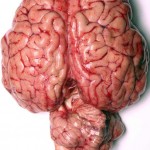The Inside of the Brain
Now let’s work our way inside the brain.

At the base of the brain the spinal cord becomes enlarged, and is known as the brain stem. The lowest level of the brain stem is the medulla, rising up from the spinal cord. The medulla controls the most basic of operations including cardiac, respiratory, vomiting and vasomotor centers, as well as regulating autonomic functions, such as breathing, heart rate and blood pressure.
As we move further up the brain stem we find the pons, involved in general arousal of the nervous system, assisting in controlling autonomic functions, sleep, and relaying sensory information between the cerebrum and cerebellum. This relaying is necessary as the cerebellum is seemingly detached from the rest of the brain, lying off to the back of the brain stem. It is involved in other basic functions, most notably motor control. It does not initiate movement, but acts as a grand director - receiving input from sensory systems and from other parts of the brain and spinal cord, and integrating these inputs to fine tune gross motor activity. The cerebellum is also involved in motor learning, such as a baby deer tottering around and correlating sensory input to motor output in order to use its legs.
The midbrain controls the visual and auditory systems as well as eye movement. Portions of the midbrain called the red nucleus and the substantia nigra are involved in the control of body movement. The darkly pigmented substantia nigra contains a large number of dopamine-producing neurons, degeneration of which is associated with Parkinson’s disease. Barry Kidston, a 23-year-old chemistry graduate student in Maryland, synthesized MPPP (a synthetic opioid painkiller) in 1976 after learning about it from an obscure 1947 paper, but screwed up a few tiny technical details leaving traces of MPTP behind. It took only three days of self-injection of the tainted MPPP for the trace MPTP to irreversibly damage the substantia nigra and for Barry to start exhibiting symptoms of Parkinson’s disease.
The bulbous thalmus extends out of the top of the brain stem, and it situated between the cerebral cortex and the midbrain, both in terms of location and function. Its functions include relaying sensory input and motor signals to the cerebral cortex, along with the regulation of consciousness, sleep and alertness. It is surrounded by basal ganglia which are primarily involved in action selection, or the decision of which of several possible behaviors to execute at a given time. Experimental studies show that the basal ganglia exert an inhibitory influence on a number of motor systems, and that a release of this inhibition permits a motor system to become active. The basal ganglia can therefore be thought of as a “behaviour switch” influenced by signals from many parts of the brain, including the “executive” prefrontal cortex.
Centered deep below the thalamus lies the hypothalamus, the connection between the nervous system and the endocrine (hormonal) system. The hypothalamus controls body temperature, hunger, thirst, fatigue, and circadian cycles. Sweeping up from the hypothalamus on both sides are several other structures collectively known as the limbic system, or “paleomammalian brain”. These ancient structures infuse emotional overtones in our experience and into our affective responses, affect long term memory, behaviour, and the sense of smell. One limbic component, the hippocampus, helps us process data and relay them to be stored in various memory circuits.
The limbic system was originally proposed as the emotional center of the brain, with the neocortex taking the role of “hard computation”. This has been cast into controversy with the discovery that the hippocampus is involved in memory retention, and the boundaries of the limbic system have been redrawn again and again since the concept was originally proposed. Some scientists propose scrapping the concept of a seperate limbic system entirely.




No comments yet.